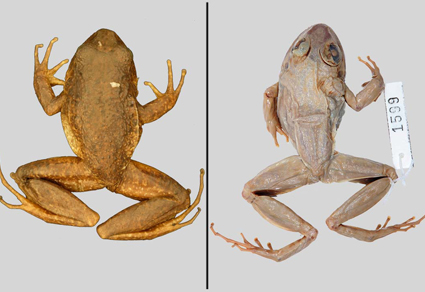Abstract
The taxonomic and nomenclatural status of Hylodes philippi and H. verrucosus have been in state of flux. Some problems regarding their identity were noticed in 1971, which were partly solved with the finding of the purportedly lost type of H. verrucosus in 2006 and the morphological revisions of both H. philippi and H. verrucous in 2008 and 2012, upon which they were considered conspecific and closely related to the Eleutherodactylus dolops group; H. verrucosus became a junior synonym of H. philippi, and the latter, a nomen dubium within Hypodactylus (later, Niceforonia). The reexamination of the type series of Eleutherodactylus dolops Lynch & Duellman, 1980 and the types of Hylodes verrucosus Jiménez de la Espada, 1875 and H. philippi Jiménez de la Espada, 1875, suggests that they are conspecific. Accordingly, Eleutherodactylus dolops is herein regarded as junior synonym of H. philippi and a new combination, Niceforonia philippi (Jiménez de la Espada, 1875), and a new diagnosis are granted. This species is known from a few scattered localities along the montane forest of the Amazonian versant of the Andes from Orellana and Napo provinces in northern Ecuador to Sibundoy in southwestern Colombia, and little to nothing is known about its natural history and population trends.
References
- Acosta-Galvis, A.R., Streicher, J.W., Manuelli, L., Cuddy, T. & De Sa, R.O. (2018) Molecular insights into the phylogenetic placement of the poorly known genus Niceforonia Goin & Cochran, 1963 (Anura: Brachycephaloidea). Zootaxa, 4514 (4), 487–500. https://doi.org/10.11646/zootaxa.4514.4.3
- Acosta-Galvis, A.R. (2021) Lista de los Anfibios de Colombia: Referencia en línea V.11.2021. Available from: http://www.batrachia.com (accessed 27 September 2022)
- Boulenger, G.A. (1882) Catalogue of the Batrachia Salientia s. Ecaudata in the collection of the British Museum. 2nd Edition. Taylor and Francis, London, 503 pp.
- Caramaschi, U. & Canedo, C. (2006) Reassessment of the taxonomic status of the genera Ischnocnema Reinhardt and Lütken, 1862 and Oreobates Jiménez-de-la-Espada, 1872, with notes on the synonymy of Leiuperus verrucosus Reinhardt and Lütken, 1862 (Anura: Leptodactylidae). Zootaxa, 1116 (1), 43–54. https://doi.org/10.11646/zootaxa.1116.1.3
- De la Riva, I. (2020) Unexpected beta-diversity radiations in highland clades of Andean Terraranae frogs. In: Rull, V. & Carnaval, A. (Eds.), Neotropical Diversification: Patterns and Processes. Fascinating Life Sciences, Springer Nature, Cham, pp 741–764. https://doi.org/10.1007/978-3-030-31167-4_27
- Frenkel, C., Guayasamin, J.M., Yánez-Muñoz, M.H. & Ron, S.R. (2018) Niceforonia dolops. In: Ron, S.R., Merino-Viteri, A. & Ortiz, D.A. (Eds.), Anfibios del Ecuador. Version 2021.0. Museo de Zoología, Pontificia Universidad Católica del Ecuador, Quito. Available from: https://bioweb.bio/faunaweb/amphibiaweb/FichaEspecie/Niceforonia%20dolops (accessed 4 January 2022)
- González-Fernández, J.E. (2006) Anfibios colectados por la Comisión Científica del Pacífico (entre 1862 y 1865) conservados en el Museo Nacional de Ciencias Naturales de Madrid. Graellsia, 62 (2), 111–158. https://doi.org/10.3989/graellsia.2006.v62.i2.63
- Gorham, S. (1966) Liste der rezenten Amphibien und Reptilien/Ascaphidae, Leiopelmatidea (sic), Pipidae, Discoglossidae, Pelobatidae, Leptodactylidae, Rhinophrynidae. Das Tierreich, 85, 1–222.
- Hedges, S.B., Duellman, W.E. & Heinicke, M.P. (2008a) New World direct-developing frogs (Anura: Terrarana): molecular phylogeny, classification, biogeography, and conservation. Zootaxa, 1737 (1), 1–182. https://doi.org/10.11646/zootaxa.1737.1.1
- Hedges, S.B., Duellman, W.E. & Heinicke, M.P. (2008b) A replacement name for Isodactylus Hedges, Duellman, and Heinicke, 2008. Zootaxa, 1795 (1), 67–68. https://doi.org/10.11646/zootaxa.1795.1.5
- Jiménez de la Espada, M. (1875) Vertebrados del Viaje al Pacífico Verificado de 1862 a 1865 por una Comisión de Naturalistas Enviada por el Gobierno Español. Batracios. Imprenta Miguel Ginesta, Madrid, 208 pp. https://doi.org/10.5962/bhl.title.5769
- Lynch, J.D. (1989) Intrageneric relationships of mainland Eleutherodactylus (Leptodactylidae). I. A review of the frogs assigned to the Eleutherodactylus discoidalis species group. Milwaukee Public Museum, Contributions in Biology and Geology, 79, 1–25.
- Lynch, J.D. & Schwartz, A. (1971) Taxonomic disposition of some 19th Century leptodactylid frog names. Journal of Herpetology, 5, 103–114. https://doi.org/10.2307/1562732
- Lynch, J.D. & Duellman, W.E. (1997) Frogs of the genus Eleutherodactylus in western Ecuador. Systematics, ecology, and biogeography. Special Publication, Museum of Natural History, University of Kansas, 23, 1–236. https://doi.org/10.5962/bhl.title.7951
- Lynch, J.D. & Duellman, W.E. (1980) The Eleutherodactylus of the Amazonian slopes of the Ecuadorian Andes (Anura: Leptodactylidae). Miscellaneous Publication, Museum of Natural History, University of Kansas, 69, 1–86. https://doi.org/10.5962/bhl.title.16222
- Mueses-Cisneros, J.J. (2005) Fauna anfibia del Valle de Sibundoy, Putumayo-Colombia. Caldasia, 27, 229–242.
- Nieden, F. (1923) Anura I. Subordo Aglossa und Phaneroglossa. Sectio 1. Arcifera. Das Tierreich, 46, 1–584. https://doi.org/10.1515/9783111434582-003
- Padial, J.M., Chaparro, J.C. & De la Riva, I. (2008) Systematics of Oreobates and the Eleutherodactylus discoidalis species group (Amphibia, Anura), based on two mitochondrial DNA genes and external morphology. Zoological Journal of the Linnean Society, 152 (4), 737–773. https://doi.org/10.1111/j.1096-3642.2007.00372.x
- Padial, J.M., Chaparro, J.C., Castroviejo-Fisher, S., Guayasamin, J.M., Lehr, E., Delgado, A.J., Vaira, M., Teixeira, M. Jr., Aguayo, R. & De la Riva, I. (2012) A revision of species diversity in the Neotropical genus Oreobates (Anura: Strabomantidae), with the description of three new species from the Amazonian slopes of the Andes. American Museum Novitates, 2012 (3752), 1–55. https://doi.org/10.1206/3752.2
- Ron, S.R. (2020) Regiones naturales del Ecuador. BIOWEB. Pontificia Universidad Católica del Ecuador. Available from: https://bioweb.bio/faunaweb/amphibiaweb/RegionesNaturales (accessed 25 May 2019)
- Ruiz-Carranza, P.M., Ardila-Robayo, M.C. & Lynch, J.D. (1996) Lista actualizada de la fauna de Amphibia de Colombia. Revista de la Academia Colombiana de Ciencias Exactas, Físicas y Naturales, 20 (77), 365–415.
- Suárez-Mayorga, A.M. (1999) Lista preliminar de la fauna Amphibia presente en el transecto La Montañita-Alto Gabinete, Caquetá, Colombia. Revista de la Academia Colombiana de Ciencias Exactas, Físicas y Naturales, 23 (suplemento especial), 395–405.


